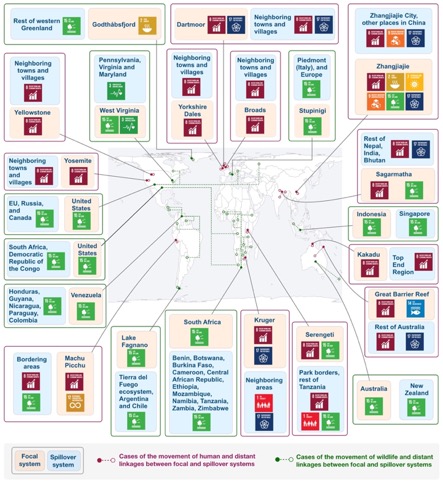New method adds and subtracts for sustainability’s true measure
Sustainability scientists at MSU find policies governing wildlife trade and tourism sometimes have more success than intended to achieve some of the UN SDGs. Yet in some cases those paths have created roadblocks and detours to success.

From loaning pandas to welcoming tourists to hike to sacred monuments, to regulating the sale of wild animals for meat, policies across the world seek to forge clear paths to sustainability.
A group of sustainability scientists at Michigan State University (MSU) examined those policies and discovered they sometimes have more success than intended to achieve some of the United Nations’ Sustainable Development Goals (SDGs). Yet in some cases those paths have created roadblocks and detours to success. The example of such unintended sidesteps is starkly illustrated in wildlife trading that provides economic benefits but has resulted in outbreaks of diseases that jump to humans, such as the current novel coronavirus.
The work is published in this week’s open-access journal Sustainability.
“Today’s world is extremely connected, and decisions are not created in a bubble,” said Jianguo “Jack” Liu, MSU Rachel Carson Chair in Sustainability. “Our analysis has showed how important it is not just to look at the direct relationship between an action and a specific problem. It’s crucial to look far and wide to see what else has been affected. Sometimes there are more wins. Sometimes, a problem solved one place creates another elsewhere. We are learning the hard way how an action in one part of the world can have consequences thousands of miles away.”
The scientists looked at 22 cases of tourism and instances of wildlife being relocated for various reasons across six continents. They looked at these cases through the lens of metacoupling – a new framework that helps scientists examine an action from the perspective of human-nature interactions across space and time.
In this paper, they lined up these cases with the 17 SDGs, adopted by world leaders from 193 countries and  identify synergies – cases where success begat more success – or trade-offs, in which gaining ground in an SDG in one place meant losing ground on another SDG elsewhere.
identify synergies – cases where success begat more success – or trade-offs, in which gaining ground in an SDG in one place meant losing ground on another SDG elsewhere.
The scorecard: they found 33 synergies and 14 trade-offs among 10 SDGs within the systems between which tourism, trade or animal movement happened – and across spillover systems – the places between.
Tourism accounts for one in 11 jobs worldwide (in the time frame of this study, before the pandemic) and is specifically called out in SDG 8 (decent work and economic growth). They found in the 12 cases they studied that beyond SDG 8, tourism in protected areas enhanced or compromised other SDGs, including SDGs 2 (zero hunger), 9 (industry, innovation and infrastructure), 12 (responsible consumption and production), 14 (life below water), 15 (life on land) and 17 (partnerships) within focal systems, and 1 (no poverty).
Examples of a synergy can be found in Sagarmatha National Park of Nepal and Serengeti National Park in Tanzania, where tourism not only fulfilled SDG 8, but also contributed management funds for the parks – a win for SDG 15. But things were different in Peru’s Machu Picchu, where the 900,000 visitors limited access for indigenous peoples and degradation of the site – a blow to SDG 12.
Moving animals around by trade, as a method of conservation or animal management – can have great benefits or harms. When raccoons were moved from their Florida homes to West Virginia to boost the local population, an SDG 15 win, SDG 3’s good health and wellbeing took a hit when the Florida coons brought rabies with them.
The current pandemic is a dramatic call to better understand how the world works, and how to scrutinize actions for possible outcomes, according to the paper’s first author Zhiqiang Zhao, who was a postdoctoral associate at MSU’s Center for Systems Integration and Sustainability (CSIS). Liu is CSIS director.
The trade of bats in China may not have seemed relevant to people in Europe or America, yet it shows us it’s just one stark reminder that it both is critical to do better to pursue global sustainability and to make sure our good intentions continue to result in good,” Zhao said. “We are following the flows and working to show ways to quickly see all sides of a story.”
Besides Liu and Zhao, “Metacoupled Tourism and Wildlife Translocations Affect Synergies and Trade-offs among Sustainable Development Goals across Spillover Systems” was written by Meng Cai, Thomas Connor and Min Gon Chung.
The work was funded by the National Science Foundation and Michigan AgBIoResearch.



 Print
Print Email
Email




